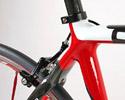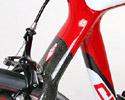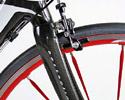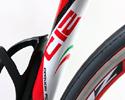
Recently on Cyclingnews.com |
On test: Battaglin C12 Carbon Ultimate, September 13, 2007
Italian carbon with Tour-winning pedigree
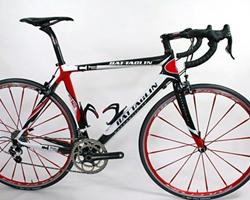
|
Battaglin has been producing high-end racing bikes since the early 1980s from its base in Marostica in the Veneto region of northeast Italy. Introduced in 2007, but with a new livery for 2008, the C12 Carbon Ultimate is its latest top level racing machine. Cyclingnews’ Ben Atkins spends most of the summer roaming the length and breadth of Europe with one to see how well his traveling companion performs.
Batta-who?
Giovanni Battaglin (pronounced bat-a-leen, with the 'g' adding a hint of itself to the 'l') rode his first Giro d'Italia in 1973 at the tender age of 21 and was the revelation of the race. If you watch the classic film, Stars and Watercarriers, which followed that particular race – and Eddy Merckx's domination of it – Battaglin is the young guy in the blue jersey of Jolly Ceramica that Merckx can't seem to shake off. A succession of injuries prevented him from realising his full potential, but in 1979 he won the polka dot climbers' jersey in the Tour de France, and in 1981 he enjoyed his golden season; taking both the Vuelta and Giro titles, something that only the aforementioned Eddy had done before.
Like many professional riders of his generation, Battaglin invested the money he made from racing in a bike factory in his hometown. The company enjoyed some quite spectacular early success: a close look between the legs of Stephen Roche during his golden season of 1987 will reveal that he did his incredible treble of Giro, Tour and Worlds on a Battaglin. More recent successes include stages in the Giro d'Italia from the likes of Emmanuelle Sella and Julio Perez Cuapio (Ceramiche Panaria).
A frame that turns heads as well as corners
The C12 is a monocoque carbon fibre frame incorporating "aerospace grade ultra high modulus T1000UHM composite with 3K weave." The tube profiles are designed to make the frame stiffer than Battaglin's previous frames, yet still allow a significant amount of vibration damping. Carefully-metered use of such high-end materials has also allowed the C12's designers to create a frame that Battaglin claims weighs less than a kilogram in the large size.
Despite all the technical language, though, Battaglin insists that the C12 "is a classic Italian road bike designed in the tradition of Battaglin". In fact, while the frame was designed and developed by the factory team, alongside their professional riders, Giovanni Battaglin himself still rides each model before it is approved for production.
The most striking aspect of the frame design is the sheer size of the tubes. The massive integrated head tube is mated to an enormously oversized down tube and top tube to create a very stiff front end. The top tube's ovalised profile changes from vertical at the head tube to horizontal at the seat tube to reinforce lateral rigidity, but also allow a certain amount of vertical compliance.
Teardrop-shaped seat stays flow into the seat tube via a large flattened monostay, which Battaglin says is specifically designed to allow more vertical compliance while ensuring the rear end is as stiff as possible in the lateral plane. Similarly profiled chain stays join a reinforced bottom bracket area to complete a rear triangle that is supposedly the stiffest Battaglin has ever made.
Battaglin bucks the current industry trend here by equipping the C12 with a woven top layer, which peeks through the frame's red and white paint scheme. While often viewed as being largely cosmetic, the woven top layer does usually provide some impact protection as opposed to unidirectional finishes and supposedly makes it a bit easier to purge excess resin during the molding process.
Our large-sized tester features a 555mm top tube and a 73.5°seat tube angle. Battaglin does not publicize the head tube angle (an inclinometer can easily reveal the frame's 'secret' if you are so inclined, however), but pairs the frame with its own C12 monocoque full carbon fork with a 45mm rake. The sum of these measurements, plus some pretty short 407mm chain stays, combines to give the bike a pretty classic overall wheelbase of 993mm.
Set up in style
Our Battaglin C12 Ultimate tester was suitably fitted with Campagnolo's top-end Record group, including its newest generation Ergopower levers, D-Skeleton brake calipers, and an Ultra Torque compact chainset and 13-26T cassette to suit the planned testing parcours in the Dolomites and Pyrenees.
Most of the remainder of the finishing kit was dominated by FSA, which supplied its Orbit CE Plus headset, the new shallow drop K-Force Compact bars clamped by an OS-115 stem, and a a K-Force SB-25 carbon seatpost topped by a Selle Italia SLR Kit Carbonio saddle. Finishing things off was a pair of Elite Pase bottle cages, made of reasonably compliant plastic instead of the usual carbon or the faux-carbon that features quite heavily in its range.
The top-shelf C12 'Ultimate' kit includes Fulcrum Racing Speed wheels – which take the rest of the set up well below the UCI's minimum weight limit – but these are strictly tubular-only. For the sake of practicality and convenience (and cheaper punctures!) we asked Battaglin to fit the (marginally) heavier Racing Zero clinchers of the 'Pro' kit, shod with a subtly coordinating pair of Michelin Pro2 Lights and Aircomp Ultralite tubes. For 2008, the brand new Mavic R-SYS wheels are also available on the C12 Pro at no extra cost.
The whole package fitted together in a symphony of colour coordination. The red and white graphics on the FSA equipment and the Elite cages nicely matched those of the frame itself. The proudly scarlet Fulcrum wheels and their grey and black Michelin tyres were met with some derisive words from riding mates, but in our opinion set the look of the bike off quite nicely.
Maglia Verde…
We picked up our C12 Ultimate from Battaglin’s Marostica factory on our way to the Gran Fondo Dolomiti Stars. While not an ideal way to ride oneself in to the characteristics of a new bike (a few sensible kilometres would have been wise before throwing ourselves at the mountains), but the timing simply didn't allow for it – and anyway, it was starting to rain as we loaded the C12 into the back of the hire car!
Our first impression of the C12 – apart from the huge tubes and stylish graphics – was that this was a seriously light bike. Even with the slightly "heavier" Racing Zero wheels, the C12 measured right on the UCI's limit of 6.8kg (without pedals). Had it been fitted with the standard issue Racing Speed tubulars, we surely would have had to start bolting things to it to keep the commissaires happy.
Despite the Battaglin statement about this being just a "classic Italian bike", there can be no doubt that the C12 was built with climbing those mountains visible on the Veneto horizon in mind. In the course of that Gran Fondo, the Etape du Tour six weeks later, and not to mention the day we climbed up to Tre Cime di Laverado to watch the Giro stage finish (especially appropriate as that’s where Battaglin took the maglia rosa in 1981), we spent a lot of time climbing and descending mountains where the lightweight C12 really came into its own.
Mass is only part of the battle on a climb, though, as it's no good paring a bike down to the bare minimum if it responds to your hard earned energy with flexibility. Thankfully, the C12 proved to be outstanding in this department as well. Despite Battaglin's rather generous provision of 35mm worth of spacers under the stem (way more than needed), the front end of the bike felt sure and rigid. Similarly, the rear triangle felt as solid as anything in recent memory; despite a great deal of low cadence grinding there was no sign of those teardrop shaped stays flexing at all. This was by no means an uncomfortable ride though, as the flat profile of the rear monostay served to absorb a lot of the fatigue inducing buzz coming up from many of the less than billiard-table-smooth surfaces we encountered.
The geometry of the frame yielded pleasantly neutral positioning and handling. This sounds a bit boring, but it really is the ideal for any bike: dimensions that are too short often makes for nervous and twitchy handling, while the opposite can make a bike it corner like an oil tanker. The C12's outstanding neutrality proved to be perfect for long days in the mountains where the predictable front end neither over- nor understeered, allowing us to comfortably push hard on descents.
…or Maglia Ciclamino?
Out on the less glamorous roads of southern England and away from the mountains,, we removed most of the stem spacers to yield a more aggressive position better suited to the next stage of testing. The lateral stiffness of the rear end that had come in so handy on the cols now proved its worth on the short sharp lumps and bumps of the South Downs. Likewise, the point-and-shoot steering that delivered us so quickly and safely around all those hairpins now allowed us to throw the bike into every turn, and the slight vertical flex in the rear eased the pain of many a broken surface and potholed lane.
After covering a couple of thousand kilometres on the C12, we can testify that the componentry of our tester was not chosen just for its colour coordination. FSA has been going 'outside the box' lately in regards to handlebar design, and the new bend on our K-Force Compact bars manages to combine the characteristics of shallow drop classic bars with anatomic ones while retaining the good points of both. The visible carbon weave just happened to compliment that of the frame really nicely – but more importantly the bar's innovative shape and extreme rigidity understandably make it a popular choice for many a fast finisher in the ProTour peloton.
Despite opting for a slightly heavier – or should we say less light – pair of wheels than would normally have been provided with the Ultimate build kit, the Pro-spec Racing Zero hoops never felt like any sort of compromise. The Pro² Light tyres forfeit some of the puncture resistance of their Pro² Race cousins, but they still proved to be formidably resilient and hardwearing, as well as being reassuringly grippy. We only suffered one puncture throughout the entire test period, courtesy of a razor-sharp piece of traditional South Downs flint that hid itself so effectively that it killed two tubes before giving itself up, and we challenge any tyre in the world to stand up to that stuff.
Conclusion? Maglia Rosa!
Battaglin has produced a truly beautiful bike in its new C12 Ultimate. While not specifically marketed at climbers, the extreme stiffness of the frame means that it excels wherever the road tilts upwards, and the excellent neutral handling created by the frame's geometry also means that you can fly down the other side as well. Attention to detail is high, both practically and aesthetically, and it is easily one of the best looking and most rigid bikes we've ridden (you make your own mind up which one of these areas is most important).
Most importantly, the Battaglin C12 Pro compares favourably to bikes that dwarf its surprisingly reasonably price tag and for this reason alone it's well worth checking out.
Weight: 6.8kg (14.99lb) (size Large, as tested, without pedals)
Price: €3,799 (as tested); €4,999 (C12 Ultimate with Fulcrum Racing Light
wheelset
Pros: Super light super stiff, super fast, comfy for such a rigid bike,
looks great
Cons: : Er, hang on, we'll think of something in a minute… the finish
is not as resilient as it might be, slightly dull name
Cyclingnews rating: ![]()
More information: www.battaglin.it
Related stories
Photography
For a thumbnail gallery of these images, click here
Images by Ben Atkins/Cyclingnews.com
- The Battaglin C12 Carbon Ultimate is built around a monocoque carbon fibre frame.
- The top tube is ovalised horizontally as it joins the seat tube and the lines continue on to the flat-profiled monostay.
- Oversized top and down tubes meet the head tube in a massively stiff joint.
- The reinforced bottom bracket area has enough carbon added for stiffness, but not so much that it makes it too heavy.
- The rear monostay is wide to prevent horizontal flex, but flat to allow some vertical compliance.
- The C12 features its own monocoque fork for sure and predictable steering.
- The C12's top tube is ovalised in the vertical plane where it joins the head tube and in the horizontal plane where it joins the seat tube for stiffess and compliance in all the right directions.
- The short chain stays put the rear tyre as close as they can to the seat tube.
- Teardrop profiled seat stays smoothly and seamlessly join the flat monostay.
- Similar teardrop profiles on the chain stays keep the rear end nice and stiff.
- The C12's rear end maintains its shape well under the stresses of both climbing and sprinting.
- Another view of how the rear monostay carries the flattened lines of the top tube around the seat tube and beyond.
- Despite the size of the head tube area Battaglin persists with the tried and tested 1 1/8" steerer tube diameter on the C12.
- Carbon weave is visible all over the C12 - especially nice through the down tube graphics.
- Aluminium dropouts are pared down to get them as light as possible.
- FSA is prominent in the finishing kit, including the K-Force SB-25 carbon fiber seat post.
- The Selle Italia SLR Kit Carbonio is claimed to weigh just 125g but is still pretty comfortable.
- Fulcrum Racing Zero wheels match well with the Battaglin's red-and-white paint scheme.
- The Fulcrum '2:1' rear lacing pattern uses two spokes on the drive side to every one on the non-drive side.
- The Racing Zero front hub is a sight to behold, but just remember to only gaze at it when you're stationary!
- The C12's drivetrain is 100% Italian, 100% Campagnolo Record.
- The compact 50/34T rings on the Record Ultra Torque CT is ready to hit the mountains.
- Elite Pase cages are not widely available, but really effective and lightweight at 32g each.
- Michelin Pro² Light clinchers offer excellent grip and good durability.
- The C12 rests on the way up the Tre Cime for the Giro stage finish (blood sweat and tears: photographer's own).
Full specification: Battaglin C12 Carbon Ultimate
|
Frame Battaglin C12 Ultimate, high modulus carbon monocoque |
Cassette Campagnolo Record UD steel/titanium, 13-26T |

